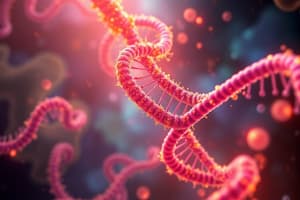Podcast
Questions and Answers
What is the correct sequence of the central dogma?
What is the correct sequence of the central dogma?
What is transcription?
What is transcription?
The copying of DNA's message to mRNA.
In which part of the cell does transcription occur in eukaryotes?
In which part of the cell does transcription occur in eukaryotes?
The TATA box is also known as the Pribnow box.
The TATA box is also known as the Pribnow box.
Signup and view all the answers
RNA polymerase II is involved in __________ synthesis.
RNA polymerase II is involved in __________ synthesis.
Signup and view all the answers
What sequences are important for promoter function?
What sequences are important for promoter function?
Signup and view all the answers
During transcription elongation, which of the following is used as a template?
During transcription elongation, which of the following is used as a template?
Signup and view all the answers
What must RNA polymerase II assemble with in order to initiate transcription?
What must RNA polymerase II assemble with in order to initiate transcription?
Signup and view all the answers
Transcription termination occurs when RNA polymerase encounters a GC-rich region that is a palindrome.
Transcription termination occurs when RNA polymerase encounters a GC-rich region that is a palindrome.
Signup and view all the answers
What are the components added to pre-mRNA during processing?
What are the components added to pre-mRNA during processing?
Signup and view all the answers
What is the role of tRNA in translation?
What is the role of tRNA in translation?
Signup and view all the answers
Study Notes
Central Dogma of Molecular Biology: The pathway is DNA → mRNA → Protein. DNA replication and transcription occur in the nucleus, while translation takes place in the cytoplasm on ribosomes. RNA synthesizes proteins from DNA, starting with pre-mRNA processing into mature mRNA.
Structure of a Gene
- Genes contain sequences recognized during transcription initiation.
Transcription in Prokaryotes
- Prokaryotes, including bacteria and blue-green algae, utilize a single enzyme—E. coli RNA polymerase (holoenzyme) for transcription.
- Transcription phases: Initiation, Elongation, Termination.
Transcription Initiation
- RNA polymerase identifies and binds to the promoter site upstream of the gene.
- Promoter region is roughly 40–60 base pairs long.
- Key sequences in the promoter: TATA box (Pribnow box) and GACA sequence.
Key Promoter Sequences
- TATA Box: Consensus sequence TATAAT located at the -10 position; significant for transcription initiation.
- GACA Sequence: Located at the -35 position; aids in DNA unwinding during transcription initiation.
Transcription Elongation
- RNA polymerase synthesizes RNA using the DNA template strand and ribonucleoside triphosphates (ATP, CTP, GTP, UTP).
- RNA synthesized resembles the DNA coding strand, with uracil (U) substituting thymine (T).
Transcription Termination
- Process continues until a termination sequence is reached.
- Common termination signal includes a GC-rich palindromic region followed by an AT-rich sequence.
- RNA polymerase detaches upon reaching the termination sequence.
Transcription in Eukaryotes
- Eukaryotic transcription involves RNA Polymerase II for mRNA synthesis.
- Requires general transcription factors to assist RNA Polymerase II in binding to the promoter.
mRNA Processing
- Pre-mRNA is modified into mature mRNA through the addition of a 5’ cap and a 3’ poly-A tail.
- 5’ cap: Guanine and phosphate added for mRNA stability and ribosome attachment.
- 3’ poly-A tail: Composed of 200-250 adenines; aids in mRNA export and stabilization against degradation.
Translation Process
- Conversion of mRNA to protein occurs in the cytoplasm.
- Translation relies on tRNA (transfer RNA) molecules.
tRNA Functionality
- tRNA: Approximately 80 nucleotides long, with a characteristic hairpin or L shape.
- One end contains an anticodon that pairs with mRNA codons, determining amino acid sequence.
- The opposite end has an amino acid attachment site, facilitated by aminoacyl-tRNA synthetase.
Studying That Suits You
Use AI to generate personalized quizzes and flashcards to suit your learning preferences.
Related Documents
Description
This quiz explores the concepts of transcription and translation as they relate to the central dogma of molecular biology. Understand the key processes involving DNA, mRNA, and protein synthesis, including their locations and roles within the cell. Perfect for students studying biosystems technology.




